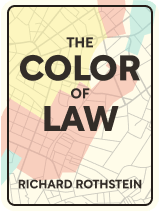

This article is an excerpt from the Shortform book guide to "The Color of Law" by Richard Rothstein. Shortform has the world's best summaries and analyses of books you should be reading.
Like this article? Sign up for a free trial here .
Why do we still have housing segregation today? Why is it difficult to fix the causes of persistent housing segregation?
We still have housing segregation today because of the historical legacy of segregationist public housing policies and the vicious cycle those policies created. Persistent problems like income disadvantages, race-blind policy, and flawed social programs have made it difficult to fix housing segregation.
Read more to fully understand the nature of housing segregation today.
The Nature and Causes of Housing Segregation Today
With the enactment of the Fair Housing Act in April 1968—a vote spurred by the tragedy of Martin Luther King, Jr.’s assassination—the private segregationist practices described above finally became explicitly illegal. (Of course, the public practices had been unconstitutional since the conclusion of the Civil War.)
However, unlike other Civil-Rights-Era statutes that protected African Americans’ right to vote or patronize any restaurant of their choosing—statutes whose benefits were felt immediately—the Fair Housing Act was powerless to rectify the decades of housing discrimination that preceded its passage. That is to say, despite African Americans’ being able to live wherever they want, racial residential segregation has persisted due to the US’s history of de jure segregation.
Racial residential segregation is difficult to remedy for a number of reasons, but three in particular: the unaffordability of quality housing, the unintended consequences of race-blind public polity, and flawed social programs.
The Unaffordability of Quality Housing
The Federal Housing Act enshrines in law the ability for African Americans to live wherever they can afford to. But historical discrimination in labor and housing markets has created intergenerational wealth and income disadvantages among African Americans, meaning they can’t afford to live where they please.
For example, the median family income of whites is currently around $60,000. For African Americans, it’s $37,000. And when it comes to wealth, the distribution is even more unequal: Whereas the median household wealth of white families is around $134,000, the median household wealth of Black families $11,000. In 1989, the most recent year for which inheritance data is available, only 6% of African Americans inherited wealth, and among those that did, the average was $42,000. Among whites, 24% inherited wealth, with an average inheritance of $145,000.
Housing segregation today is persistent because African Americans are also less economically mobile than white Americans. While the average American born into the bottom income quintile has a 30% chance of making it to the middle quintile, Black Americans only have a 26% chance. In terms of wealth mobility, white children have a 42% chance of rising above the bottom quintile; Black children have a less than 25% chance of rising.
The Vicious Cycle of Racial Residential Segregation
Epitomizing the cyclical nature of racial residential segregation, one of the reasons African Americans are less upwardly mobile than whites is their de facto confinement to poor neighborhoods. Poorer neighborhoods lack the services and opportunities—sufficiently staffed and equipped public schools, greengrocers, unpolluted air, safe streets—that put children on an upward trajectory.
For example, one 2013 study found that African Americans between the ages of 13 and 28 are now ten times more likely to live in poor neighborhoods than their white counterparts. The same study found that 67% of Black families who, a generation ago, lived in the poorest 25% of US neighborhoods continue to live in such neighborhoods. Whites who lived in such neighborhoods have fared much better: Only 40% of those families still live in the poorest neighborhoods.
Making matters worse, the value of homes in predominantly white neighborhoods has appreciated considerably in the last 50 or so years. This development has a dual effect: It makes homes in those neighborhoods even more unattainable for African Americans and it entrenches the intergenerational wealth gap between Blacks and whites (because white parents pass on their appreciated homes to their heirs).
Homes in and around the famous Levittown subdivision provide a stark example of housing segregation today. In 1948, a one-bedroom in Levittown—which excluded African Americans—went for about $75,000 in today’s dollars. Today, that home—even without major remodels or updates—sells for about $350,000.
Compare this with nearby Lakeview, NY, a predominantly African American town. In 1948, a comparable one-bedroom house cost approximately $75,000 in today’s dollars, but today, that same one-bedroom house is only worth $90,000–$120,000. In short, Black families denied homes in Levittown missed out on 80% of the wealth generation enjoyed by Levittown’s white families.
The Unintended Consequences of Race-Blind Policy
Although many policies passed in the 20th century had no explicitly discriminatory purpose, the fact that segregation was already entrenched meant that these race-neutral policies exacerbated housing segregation today.
The most salient example is the mortgage interest deduction, the tax break given to homeowners. Because homeownership for many African Americans was unattainable—due to the discriminatory public policies of the FHA and other agencies, among other bodies—African Americans were largely excluded from this government subsidy.
Another race-neutral policy that has had a discriminatory effect on African Americans is the government’s support of private transportation, the US highway system in particular. One material impact of new highways was the displacement of African American and integrated communities to make way for their construction. But highways also favored suburban whites, who had the means to access cars, and disadvantaged African Americans, who relied on public transportation. While (predominantly white) suburbanites were able to commute to their jobs in the city centers, (predominantly Black) urbanites couldn’t reach jobs in the suburbs.
Baltimore’s transportation policies illustrate this disparity. From 1975 to 2015, suburbanites resisted the construction of rail lines that would link downtown Baltimore to the suburbs. A Johns Hopkins study of a failed initiative in 1975 found that the suburbanites believed the train would allow “inner-city” African Americans to travel to their towns and rob their homes.
Likewise, in 2015, Maryland’s governor nixed a rail-link plan that would connect (heavily African American) downtown Baltimore with a (largely white) suburb and diverted those funds to highway maintenance. The NAACP filed a civil rights complaint with the US Department of Transportation, alleging the decision discriminated against African Americans. In 2017, the Trump administration closed the complaint without explanation.
Flawed Social Programs
Federal and local governments have enacted programs to help low-income families secure affordable housing. Unfortunately, these programs have contributed to housing segregation today rather than remedy it.
The Low-Income Tax Credit
One example of such a program is the federal Low-Income Housing Tax Credit. This program incentivizes developers to build affordable units for low-income families by offering tax breaks on projects that include those units.
Although the program has the potential to integrate neighborhoods in theory—if developers built these affordable units in high-income (and thus traditionally white) areas—in practice it has failed to remedy racial residential segregation. This is for two reasons:
- Local communities can veto developers’ proposals. Upper- and middle-class areas—more often than not predominantly white—will veto proposals for low-income units.
- Developers themselves prefer building in already segregated neighborhoods. Low-income neighborhoods—composed predominantly of people of color—offer cheaper land and easier logistics for building low-income housing.
A 2005 study of tax-credit projects nationwide found that approximately 75% of the low-income units were placed in neighborhoods with poverty rates of at least 20%.
Housing Choice Vouchers (“Section 8”)
A second key example of counterproductive public policy is the Housing Choice Voucher program, commonly known as “Section 8.” This program subsidizes low-income families’ rental payments. The theory is that housing vouchers will supplement low-income families’ rent budgets enough to allow them to live in high-income areas.
Unfortunately, landlords in better-off areas often refuse housing vouchers, and voucher amounts are typically too meager to enable families to move to high-income areas. For example, in 2010, over half of the families with dependent children who used housing vouchers rented in areas with a poverty rate of over 20%.
Case Study: Ferguson, Missouri
Ferguson, Missouri, a suburb of St. Louis and the site of intense protests against police brutality in 2014, exemplifies the failures of public policy to desegregate neighborhoods and improve the financial situation of African Americans.
Ferguson’s story begins with “urban renewal” projects—redevelopment projects and highway expansions—in St. Louis. The upshot of these projects was the razing of low-income urban neighborhoods and the displacement of their residents. When federal tax credits and housing vouchers weren’t sufficient to allow these displaced residents to move to middle-class—and predominantly white—towns in St. Louis’s metropolitan area, the displaced were forced to relocate to “inner-ring” suburbs like Ferguson. As the low-income, predominantly minority, population in these inner-ring suburbs grew, the white residents moved out, and all the problems of racial residential segregation arose once more.

———End of Preview———
Like what you just read? Read the rest of the world's best book summary and analysis of Richard Rothstein's "The Color of Law" at Shortform .
Here's what you'll find in our full The Color of Law summary :
- How racial residential segregation is the result of explicit government policy
- The three reasons why racial segregation is so difficult to reverse
- The steps that could lead to a more integrated and equitable society






